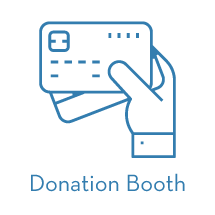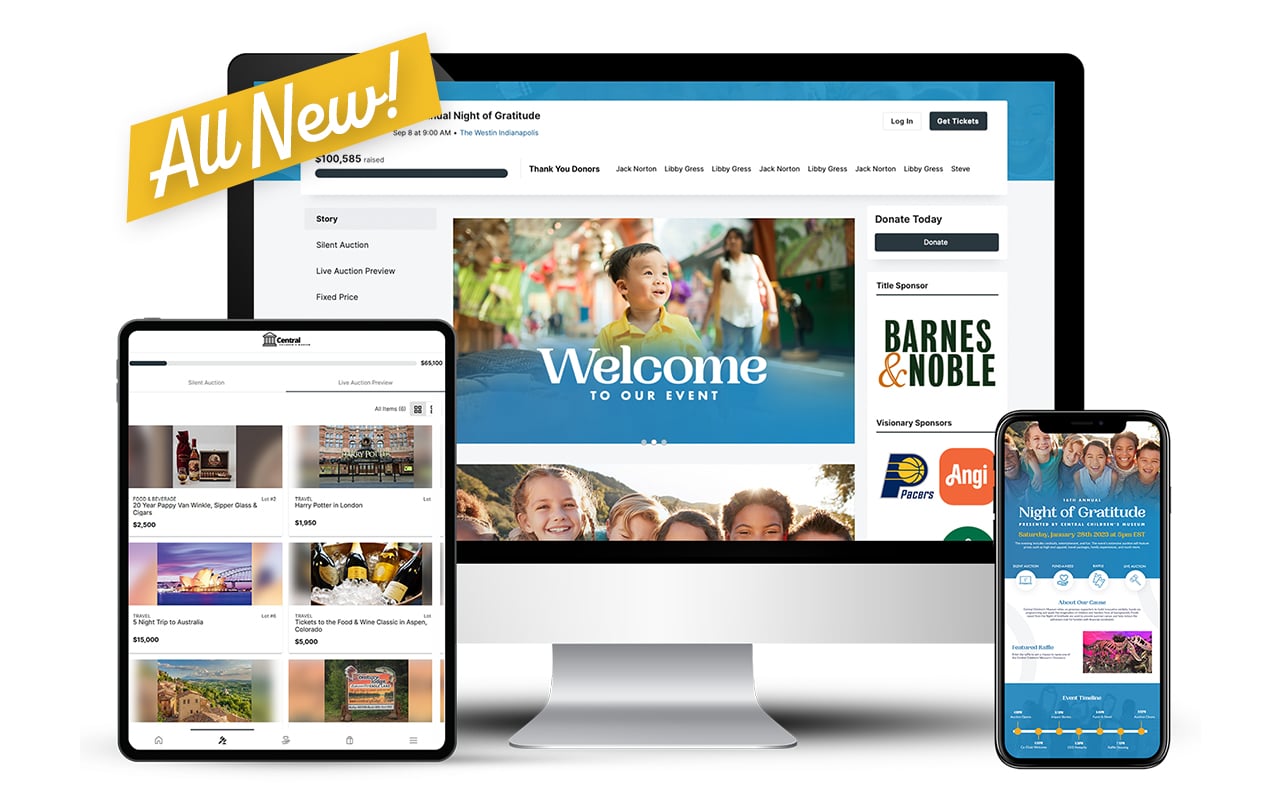Live Auctions | Plan the Perfect Event and Increase Bids
Live auctions are among the most popular and reliable fundraising events for nonprofit organizations. They’re a perfect way to raise financial support while hosting an unforgettable night that will keep your donors engaged with your work for years to come.
If your organization is considering hosting its first live auction, you’ve come to the right place. We’ll walk through all the ins and outs of these classic events and point you to some handy resources to get you started planning your own. Let’s start with the basics:
What are live auctions?
Live auctions are a type of charity auction. During live auctions, an auctioneer runs the bidding by introducing each item and guiding bid amounts. Guests place bids by calling out amounts, raising bid paddles, or otherwise catching the auctioneer’s attention.
Why host a live auction?
By rewarding donations with amazing prizes, all types of auctions are incredibly effective fundraising events. Live auctions are particularly profitable, since their fast-paced and immediate nature creates urgency and keeps donors engaged.
Let’s walk through all the essentials you and your team will need to know before getting started with your live auction. We’ll cover:
1. How do live auctions work?
Step 1: Pre-register your bidders.
To participate in the auction, each bidder must pre-register at check-in on the night of the event. They’ll each receive a unique bidder number and a bid paddle with their number on it, which they’ll use to place bids throughout the live auction.
Step 2: Open the program.
Once guests are settled at their tables, the auctioneer will open the program by announcing the first item. Volunteers will either bring the items onto the stage for guests to view, or an image of the item will be displayed on a projector behind the auctioneer.
Step 3: Start at the starting bid amount.
The auctioneer will start the bidding on each item at the starting bid amount. As with silent auctions, the starting bid is set at around 30-50% of the item’s market value. The starting bid dictates the minimum amount that the first bidder can bid.
Step 4: Accept bids using bid paddles.
While there are other ways to facilitate live auction bidding, bidders will most commonly bid by raising bid paddles to get the auctioneer’s attention. Once spotted and prompted by the auctioneer, the bidder will call out the amount they wish to bid.
Step 5: Have the auctioneer guide the bidding.
Bidding must start at the minimum bid amount. While there’s no official minimum raise set, the auctioneer will generally guide the minimum raise amount by calling out increments based on bid activity.
Step 6: Close the bidding.
The bidding for each item remains open until no more bids are placed. Bidding on that item will close, and it will be sold off to whoever placed the final, highest bid. The winner is up to the sole discretion of the auctioneer.
Step 7: Inform winners of expectations.
By placing a bid, the winning bidder has agreed to buy the item at the stated amount and assumes full risk and responsibility. Make sure guidelines are clear from the start, so bidders know what’s expected.
Step 8: Give the auctioneer full say over proceedings.
Live auctions are fast-paced and often imperfect. To make quick decisions and keep up the pace, it will be the auctioneer’s sole responsibility to settle any disputes and have final say over all proceedings.
2. Should your organization host a live auction?
Before committing to hosting your own live auction, you and your team should carefully consider a few major pros and cons. Live auctions are highly effective and engaging fundraising events, but they’re not for every nonprofit or audience.
Pros of Live Auctions
- More engaging. Because the auction is the central focus of the night, bidders will be more actively participating. This makes live auctions one of the best types of fundraising events for engaging donors.
- Friendly competition. Live auctions are the only type in which bidding isn’t anonymous, which adds a touch of friendly competition. Guests’ desire to beat out friends and peers on certain items can heighten the bidding spirit!
- More urgent. With live auctions, people will be bidding and winning items on the spot. This urgent nature can be a huge motivator for bidding. When guests know they have only one chance at winning an item, they’ll bid and bid fast.
Cons of Live Auctions
- More structured. The live auction is the most structured. Since guests will essentially be participating in a live performance, they’ll have less control over their event experience.
- No anonymity. Open bidding can be a double-edged sword. While some guests will turn bidding into a friendly competition, others might feel uncomfortable bidding against those they know.
- Complicated and expensive planning. Live auction planning requires the organization of many logistics. The costs associated with all of these logistics can quickly turn the event into an expensive endeavor.
Learn more about each type of charity auction.
3. What settings are good for live auctions?
A number of settings and venues are tailor-made for live auctions. Explore some of the most popular spaces for live auctions and consider which might be the best fit for your organization:
Gala
- Why it’s perfect for auctions. Galas are large parties filled with many different types of entertainment and events. An auction can easily be incorporated into the program to provide organizations with an extra opportunity to fundraise.
- Who it’s great for. Galas make particularly excellent auction settings for large organizations holding large-scale annual events. They’re generally catered to slightly older crowds in wealthier demographics.
Art Museum
- Why it’s perfect for auctions. With excellent lighting and rooms that are meant for displaying beautiful objects in all of their glory, art museums were practically built for auctions.
- Who it’s great for. If you’re raising money for a museum or another art and culture based nonprofit, this is the setting for you. While an art museum will reflect your cause no matter what, it will be especially fitting if you happen to be hosting an art auction!
School Auditorium
- Why it’s perfect for auctions. Considering they have stages and plenty of seating, school auditoriums are the perfect live auction setting. Plus, they usually cost little if anything to rent out!
- Who it’s great for. As you could probably guess, school auditoriums make excellent auction settings for K-12 schools and universities. These organizations are lucky enough to have a venue right on site.
5-Course Dinner
- Why it’s perfect for auctions. During live auctions, guests are usually placed at tables and arranged in a seating chart. The format of a live auction is perfectly conducive to a 5-course dinner setting.
- Who it’s great for. Because they can be held practically anywhere, 5-course dinners can be great auction settings for organizations of all shapes and sizes. The atmosphere is up to you!
Golf Tournament
- Why it’s perfect for auctions. Live auctions are commonly incorporated into golf tournaments to help organizations raise extra money. Guests can enjoy the tees, then top off the night by bidding on amazing items!
- Who it’s great for. Golf tournaments are the ideal auction setting for organizations with an athletic base. With a day on the course, you’re sure to meet your sports-loving supporters where they want to be.
Honors Night or Banquet
- Why they’re perfect for auctions. Awards banquets or honors nights are usually held in a venue with an auditorium. As live auctions are essentially live performances, this setting should be the perfect place for one.
- Who it’s great for. Obviously, you’ll need to have occasion to host an awards banquet or honors night! Since these types of events vary in scope, they’re well suited to all types of organizations.
4. How to Plan a Live Auction
Step 1: Set a goal and budget.
Planning a live auction has many components, and expenses can quickly add up. You’ll need to set a clearly defined budget to make sure that the event doesn’t break the bank.
Additionally, you’ll want to decide on a fundraising goal. This will help you determine how many items you need to auction off and at what amount you should set your starting bids.
Step 2: Recruit an auction team.
Live auctions require many hands, and you’ll need a dedicated and diverse team to help the event planning process run as smoothly as possible.
You’ll also need to recruit lots of volunteers to ensure that the event itself goes off without a hitch.
You’ll need volunteers to handle three distinct aspects of your live auction:
- The event planning team consists of staff and/or volunteers who are in charge of most event-planning logistics, including booking the venue, organizing volunteers, marketing the event, and more.
- The procurement team solicits auction items for the event. It can be made up of staff, volunteers, or both. All that matters is that each team member is comfortable asking for donations!
- The volunteer team will help you execute your event on the big night. At the very least, you’ll need auction spotters to help the auctioneer spot bids and volunteers to help you run registration and checkout.
Step 3: Solicit auction items.
Of course, if you want to host an auction, you’ll need items to auction off!
Although the items you procure will depend largely on what donors are willing to give, it can be helpful to brainstorm about what items might appeal most to your donors. That way, you can send your procurement team out to look for the items that will be most profitable.
If you’ve hosted an auction in the past, and you kept detailed records, you can look back on previous years to see which items were the most popular sellers.
You might also want to consider featuring consignment items, which are big ticket items that you only have to pay for if you sell. They work particularly well for live auctions, where each item receives solo time in the spotlight.
Now, have your team go out and start soliciting!
Learn more about auction item procurement.
Step 4: Pin down a date and location.
About 9-6 months before your auction, you should pin down a date and location.
When deciding which venue to book and when, think about how many people will be attending, the ambiance of the event, and your supporters’ general availability.
For live auctions, your organization should ideally find a venue with a stage so that the auctioneer has a place to run the show and guests can clearly see the items. There should also be plenty of seating (or room for tables and chairs!).
Step 5: Hire an auctioneer.
The auctioneer will be the ringleader of your live auction. They’re the person who will run the program by introducing the items and scoping out the audience for bids. In other words, they’re one of the most important parts of your auction, so choose wisely!
Seeing as the auctioneer’s role is so specialized and integral to the success of your auction, your organization might want to consider hiring a professional.
Need help finding a great auctioneer? Explore the services of our preferred fundraising partners.
Step 6: Promote the event and sell tickets.
Now that you have all of the essentials for hosting a live auction in order, it’s time to start telling supporters about your event!
You’ll first want to compile a guest list. When thinking about who to invite, consider the size of the venue and who in your donor base has the capacity to bid on your auction items. Then, start sending out invites! If you’re using event planning software, you can sell tickets online to provide supporters with more convenience.
Make sure to include the link to your online ticket page when you send out invites so that donors who want to attend can RSVP “yes”!
Step 7: Promote your auction items.
Giving guests a taste of your amazing auction items ahead of time is sure to get them hyped up about the event! If you’re using auction software, you can set up an online auction site to serve as an auction catalog.
Continuously update your catalog as new information and items become available. You can even open up online bidding in advance to raise even more money!
There’s some essential information that needs to be included in your auction catalog:
- Event details and a short introduction to your organization
- The event schedule
- Where your organization is putting the proceeds
- Rules for bidding
- Sponsor advertising (if applicable)
- The name and number of each item featured
- A brief (but specific) description of each item
- The starting bid amount and market value of each item
- The minimum raise amount for each item
- High quality photos of each item (whenever possible)
Step 8: Set up the live auction.
Congratulations! It’s now the day of the event and most of your planning is over.
The day of your auction, you and your volunteers will want to get to the venue well before the event starts to set up.
Here are some of the major tasks you’ll likely have to complete:
- Double check your seating chart to ensure it accommodates all guests.
- Arrange tables and chairs around the venue. Generate and set place cards.
- Organize and place auction items so they’re ready to be displayed as the auctioneer introduces each one.
- Set up and test the sound system. You’ll also need to set up a projector if you want to display images or information during the auction.
- Set up a registration table and a checkout area with multiple queues.
During this stage, make sure you also have volunteers appointed to each task and that everyone is clear on their responsibilities.
Step 9: Execute your auction event!
Now that you’re all set up, it’s time to enjoy your event! All of your team’s hard work will pay off tonight as your guests have a great time and as your organization raises support for its work. Auctions are among the most engaging fundraising events, so enjoy it.
Your auction will probably unfold a little something like this:
- Arrival. Guests start arriving and check-in at registration. If using bid paddles, each guests will receive a bid paddle with their bidder number on it.
- Bidding. Once it’s time for the auction to begin, have the auctioneer open the bidding by introducing the first item. If appropriate, now is also a good time to serve alcoholic beverages, as it tends to increase bidding. Of course, encourage guests to drink responsibly!
- Checkout and Pick-Up. The auction has come to a close. Direct winners to the checkout line so they can pay for and receive their items.
- Acknowledgement. Before everyone leaves, make sure to thank your attendees for their support. Follow up with personal thank-yous after the event.
Once all the guests are gone, break down your setup, clean up the venue, and celebrate a job well done!
Step 10: Track your performance.
Your event might be over, but you’re not done quite yet!
It’s important to track your performance, especially if you’re going to make auctions a recurring staple of your fundraising events.
Consider a few useful questions for evaluating your performance:
- Did we have a good turnout?
- Did we reach our fundraising goal?
- Which items were the most popular?
- Did any items not receive bids?
- Who were the top bidders?
- What could we do better next time?
The most robust auction and event planning software will allow you to generate a wide variety of reports that will give you detailed insights into your auction items and bidders.
5. Live Auction Planning Checklist
After familiarizing yourself with the general process of planning a live auction as outlined above, copy or bookmark this checklist. Use it as a quick reference to make sure you and your team don’t forget any of the most crucial steps.
 Book a venue.
Book a venue.
Of course, you can’t host an auction without an event space to host it in! Book an appropriate venue 9-6 months before your event.
 Procure auction items.
Procure auction items.
You’ll have no way to fundraise if you don’t have items to offer! All charity auctions need a range of amazing auction items to see fundraising success.
 Hire an auctioneer.
Hire an auctioneer.
The auctioneer will be in charge of running the show. Your organization should consider hiring a professional to fill this role.
 Compile an auction catalog.
Compile an auction catalog.
Auction catalogs are great for creating hype. If using auction software, you can create an online catalog by setting up an auction site.
 Recruit volunteer auction spotters.
Recruit volunteer auction spotters.
Spotters help the auctioneer scope out the audience for bids. You’ll also need a team of volunteers to cover more general event-day tasks.
 Stock up on bid paddles.
Stock up on bid paddles.
While there are plenty of other ways that the audience can bid during a live auction, bid paddles help the auctioneer spot bids.
 Create event programs.
Create event programs.
Event programs highlight contributors, provide a schedule for the night, and overall orient guests with your event.
 Double-check your sound and lighting.
Double-check your sound and lighting.
Before the program, do a check of your sound system to make sure your audience will be able to hear the auctioneer.
6. Live Auction Item Ideas
Having trouble thinking of or finding the perfect live auction items? Remember that high-performing auction items tend to have a few characteristics in common:
- They fit into guests’ interests. As obvious as it may seem, for people to bid on your items, they genuinely have to want them. Items that fit into your supporters’ interests will naturally appeal to your guests.
- They fall within a reasonable price range. As much as somebody is dying to win an item, they simply won’t bid if they can’t afford to. In order to see fundraising success, your attendees must have the financial capacity to bid on the items you’re featuring.
- They’re rare or unique. It’s the basic law of supply and demand. The rarer an item is, the more valuable it is. When you offer objects or experiences that your guests can’t find anywhere else, they’re sure to bid in fear of missing out!
To help get you started thinking of auction items to locate and solicit, we’ve compiled a few top performing ideas in various categories:
 Travel & Outdoors
Travel & Outdoors
- Exotic getaway
- Guided tour
- Skiing trip
- Hot air balloon ride
Tip: Check out OneCause’s travel packages full of all the adventures your donors & supporters could be looking for at your next live auction.
 Arts, Culture, & Entertainment
Arts, Culture, & Entertainment
- Signed memorabilia
- Walk-on role in a TV show
- Awards show passes
- Art or music lessons
 Food & Drink
Food & Drink
- Private cooking lessons
- Wine or beer tasting
- Cocktail basket
- Dinner with a celebrity
 Sports & Activities
Sports & Activities
- Tickets to a championship game
- Rare baseball cards
- Personal training services
- Complete home gym set
 Services & Community
Services & Community
- Maid services for a year
- Total makeover
- Chauffeur for a week
- Local business tour
 Kids & Family
Kids & Family
- Class pizza party
- Custom-built treehouse
- Professional family photos
- Disney World adventure
Check out our comprehensive list of 115+ auction item ideas!
7. Live Auction Best Practices
Even after familiarizing yourself with the planning process and carefully considering what sorts of items to procure, it’s important to keep a few live auction best practices in mind as you move forward:
Treat the items as the stars.
It’s important to show off your auction items as much as possible during your event. Being able to view your auction items in person will make them more tangible and will help guests see their full value, resulting in more bids.
Have volunteers bring each item on stage as it’s being auctioned off. Remember to choose a venue with good lighting so guests are able to see your items clearly!
Choose the order wisely.
To maximize bids, your organization must be strategic about the order in which you auction off your items. We recommend holding your Live Appeal (Make A Donation, Fund A Need) BEFORE you do the Live Auction. This allows everyone to participate in the fundraising, before going to a revenue activity that focuses mainly on high-end donors (i.e., Live Auction).
Once your Live Appeal is done, time to turn to the Live Auction. Again, order is important when creating the flow of this part of your event. If you auction off the most popular sellers too soon in your live auction, many guests will leave before the bidding has closed.
Featuring the biggest sellers 3/4 of the way through your auction will maintain interest without making guests wait too long for what they came for.
Emphasize the cause.
Emphasizing philanthropy at your auction will help your organization receive more bids. When guests are reminded that they’re at a charity auction, it puts it into their minds that it’s OK to spend money, since it’s going to a good cause!
On your event site and at your auction, introduce supporters to your organization and tell them specifically how you plan to use the auction proceeds.
Serve dinner during the auction.
If you serve dinner before your live auction, you run the risk that people will get tired and leave before the bidding even starts. Make sure guests are fresh and ready to bid by serving dinner during your auction instead.
When people can wine, dine, and socialize all while enjoying the auction, they’ll be much more entertained and engaged.
8. Boosting Revenue at Your Live Auction
We have a lot of experience helping nonprofits host their most profitable auction events ever. There are a few reliable ways to boost the return on all the hard work you’ve put into planning and organizing your own event, so study up! Consider these tips:
Make plenty of live appeals.
When making a live appeal, your emcee or auctioneer will ask guests for donations to help your organization reach a fundraising goal by the end of the night.
Guests can donate through a text-to-give service or by filling out paper pledge cards. As guests are submitting their gifts, display a fundraising thermometer so they can keep track of how close they are to reaching the goal!
 Set up a donation booth.
Set up a donation booth.
A donation booth provides guests with a donation opportunity in case they don’t walk home with an item (or in case they just want to give more!).
By setting up a booth, guests who want to donate can do so quickly and conveniently instead of having to wait in a long line at checkout. If you’re using text-to-give at your event, guests can make gifts right from their phones, so there’s no need to set up a booth.
 Hold a raffle portion of the event.
Hold a raffle portion of the event.
Hosting a raffle can be an excellent way for your organization to supplement the money you raise at your auction.
Use one of the items you’ve received as a raffle prize. Sell tickets as a fixed-price item on your event site or at a booth during the live auction itself. Remember that raffle regulations vary by jurisdiction, so check with your local authorities to make sure you’re complying with the rules.
 Seek out corporate sponsors.
Seek out corporate sponsors.
Corporate sponsors can help you increase your auction ROI by helping your organization fund and market the event. Many will even donate auction prizes.
The business receive additional advertising from your event marketing materials and the image boost that comes with being associated with a good cause. For the best chance of finding corporate sponsors, see if you can leverage any relationships in your network.
 Consider charging for admission.
Consider charging for admission.
Since not all of your attendees will walk home winners, nevertheless place bids, your organization might consider charging an admission price.
Many event planning software platforms have ticketing tools that will allow guests to purchase ticket packages and sponsorships online. You can set multiple ticket packages (for example, individuals, couples, and VIP) and sponsorships to provide guests with more flexibility.
 Sell ads in your auction catalog.
Sell ads in your auction catalog.
When your team is out soliciting auction items, have them provide donors with the option of buying an ad in your auction catalog. Many businesses will jump on the opportunity for additional advertising!
If you’re creating a catalog online by using an auction site, feature sponsors’ logos directly on the homepage. If you’re printing a physical catalog, leave the most prominent spots for your biggest sponsors!
Explore how ticket upgrades can boost auction profits.
9. How Live Auction Software Can Help
Item & Package Management
Centrally record all data about each of your items for straightforward tracking throughout the planning process. Group items into packages and auto-generate item numbers.
Event Websites
Auction software enables you to generate a site branded to your event. Promote your items, sell tickets, take standard donations, and more. You can even open up online bidding before your auction to raise even more money!
RSVP Management
All RSVPs, ticket sales, and attendee data are tracked in the same platform, making it easy to stay on top of your guest list. You can even assign guests seats and tables.
Reporting & Analytics
Run a myriad of reports on anything from your guests’ habits to your item performance to the overall health of your event. Using auction software is the only way to gain detailed insights, so you can improve for next year!
Now that we’ve covered all the ins and outs of planning and running a live auction, you’re ready to get started! As you begin working, though, it’s still a good idea to continue researching best practices, success stories, and other fundraising techniques to incorporate.
Wrapping Up!
Explore these additional resources for even more ideas:
- Charity Auctions: 12+ Tips to Get Started: In need of some ideas to get your charity auction started? Check out this blog.
- Charity Auction Software: Score More Bids: Discover how to capture more donations with charity auction software.
- Silent Auction Donation Request Letter: The How-To Guide: Learn how you can craft a more impactful silent auction donation request letter.
Get Started with OneCause
Powerful missions need powerful fundraising software! The OneCause Fundraising Platform makes giving modern, flexible, and seamless to drive deeper engagement and grow your fundraising. Take a look at this versatile all-in-one fundraising software that meets the expectations of today’s donor, supporting any event, in-person, virtual, or hybrid.













 Travel & Outdoors
Travel & Outdoors Arts, Culture, & Entertainment
Arts, Culture, & Entertainment Food & Drink
Food & Drink Sports & Activities
Sports & Activities Services & Community
Services & Community Kids & Family
Kids & Family




 Set up a donation booth.
Set up a donation booth. Hold a raffle portion of the event.
Hold a raffle portion of the event. Seek out corporate sponsors.
Seek out corporate sponsors. Consider charging for admission.
Consider charging for admission. Sell ads in your auction catalog.
Sell ads in your auction catalog.
